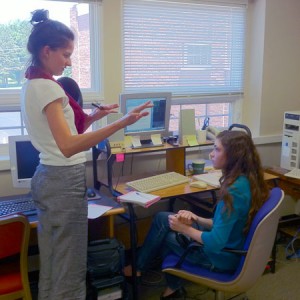Listening Post: Making sound into a story

Producer Tasha Haverty (left) gives intern Jasmine Wallace instructions on how to get her final edit into the control-room computer, ready to broadcast.
Mark Twain famously said, “Those that respect the law and love sausage should watch neither being made.” And the same could apply to many other things in life. But today I got a fly-on-the-wall perspective of the way radio gets made, and it was a pleasure to behold.
NCPR has gotten into the business of training a new generation of public media journalists, courtesy of a grant from the Knight Foundation through the Adirondack Community Trust. This means that most interns who come through the station now get a chance to record, edit and produce at least one feature story for broadcast. Today it was Jasmine Wallace’s turn.
I think of Jasmine as “my” intern, because she is based in the web office to work on (among other things) post-production of audio, text and images–doing everything it takes to convert a broadcast item into a feature for the website. But the making of the audio feature itself is something I only get to experience from a listener’s perspective, normally.
Producer Natasha Haverty had already been working with Jasmine on the field work side of gathering sound, on planning the structure and focus of the piece, and doing a rough edit. I heard that, and to me it sounded pretty good. But all day today, the news and audio gurus have been coming past my desk to Jasmine’s work station to help put the polish on the feature.
First was news director Martha Foley, who worked with Jasmine to distill the audio down to only those elements essential to telling the story, and ordering those elements in the best way to create the narrative experience. Next it was production manager Joel Hurd, who helped her to polish the sound of the piece, to create smooth transitions, to layer background and foreground sound, and establish the pacing–showing how microsecond timing and minute adjustments in levels boost impact. Then Natasha came back in, coaching Jasmine on how to write a host’s intro that would set the stage for the piece and provide context for what the listener was about to hear. And last, she showed Jasmine how to get the finished audio where it was needed, along with the intro script and other information, so it could fit into the work flow of Friday’s edition of The Eight O’Clock Hour.
Together, these folks approach sound in the way a poet approaches language. And the result is work of art. Listen for Jasmine’s story tomorrow in the Heard Up North feature. I’m sure you’ll be hearing from her again.
Tags: listeningpost








and all I do is turn my radio on…..
Little did I know…..
She is being coached by the best!
Learn all that you can!
Thanks for all the good news in the morning.
Julie
Fascinating inside report on that production scenario..
Thanks for that, Dale!
Klaus
That’s great Dale,
I’ve been hearing some stories filed to NPR where the narator is perfectly clear but the primary source is not as distinct. The use of some compression or EQ is needed in some cases. In other cases serious noise cancelation or translation is needed. The process you describe bodes well for our local news. It’s great to hear that NCPR is getting the next generation thing going to keep up the good radio.